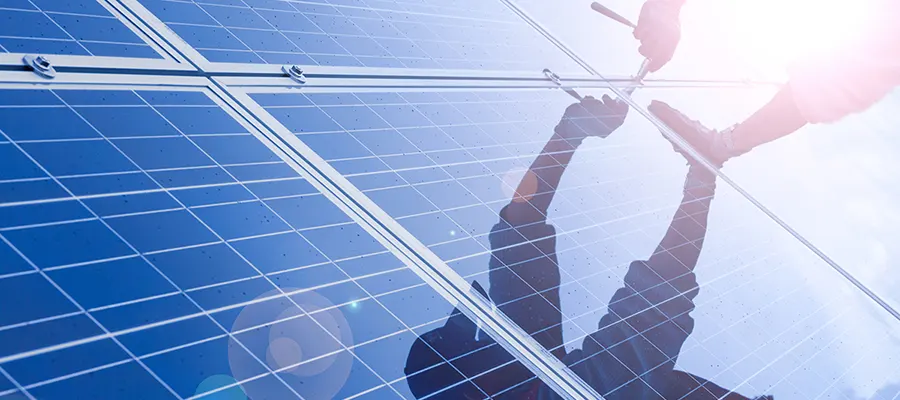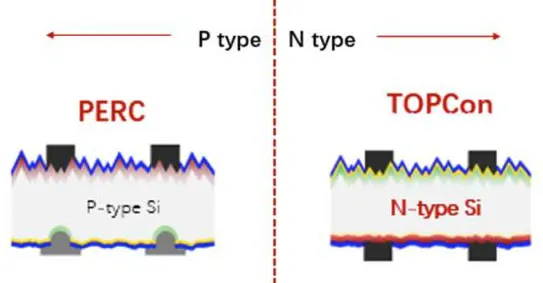- HOME
- ABOUT US
- SOLUTIONS
- Metal Roof PV Mounts and Systems
- Flat Roof Solar Panel Mounting Systems Solutions
- Tile Roof Solar Mounting Systems Solutions
- Solar Tracking Solutions for Commercial PV Projects
- Ground Solar Mounting Systems Solutions
- Floating Solar Solutions - PV Systems
- PV Solar Carport Mounting Systems Solutions
- Balcony Solar Panel Mounting Systems Solutions
- PRODUCTS
- PROJECTS
- COMPANY NEWS
- BLOG
- Contact Us

When it comes to solar panel installation, you generally have a few options. The first consideration is whether to use monocrystalline or polycrystalline silicon solar panels. Then you have to decide between N-type and P-type solar panels. Indeed, a photovoltaic (PV) module with an N-type solar cell or a P-type solar cell can make a difference in the module's performance and lifespan.
In this article, we will explain the structure of both types of solar cells, how they function, the differences and benefits of N-type and P-type solar panels, as well as other interesting information.
Monocrystalline vs. Polycrystalline Solar Panels
Let's first discuss the initial choice of monocrystalline vs. polycrystalline. Solar cells are all made of silicon, but the type of silicon varies. Monocrystalline silicon, for example, is known to be more efficient. Polycrystalline silicon, on the other hand, is less expensive to produce but less efficient.
While monocrystalline cells are the most efficient, they suffer the most if the solar panel is partially obscured by shade or dirt. When comparing monocrystalline vs polycrystalline solar panels, polycrystalline cells have a lower heat tolerance and also do not last as long.
Both are equally popular, for the most part. Monocrystalline is preferred by those who want the highest quality and can afford to pay a little more. However, polycrystalline still performs well, and many people prefer the less expensive option when choosing between monocrystalline and polycrystalline.
How the Solar Power Comes From Solar Cells
In general, solar cells connected together form a solar panel. When exposed to sunlight, a solar cell made of two layers of silicon allows electricity to flow through it. The first layer is positively charged, while the second is negatively charged.
As photons enter the layers, they transfer their energy to the silicon atoms in the form of electrons. Electric current is produced when photons strike the silicon layers and pass through the junction between the positive and negative layers.
N-type vs. P-type Solar Panels: What’s the Difference?

A conventional crystalline silicon (c-Si) solar cell is a silicon wafer that has been doped with various chemicals to promote power generation. The number of electrons is the primary distinction between p-type and n-type solar cells. A p-type cell is typically doped with boron, which has one fewer electron than silicon (making the cell positively charged). Phosphorus, which has one more electron than silicon, is used to dope an n-type cell (making the cell negatively charged).
● Efficiency: The most powerful solar cells on the market today are n-type solar cells. The longer carrier lifetime is the primary reason for their superior efficiency. The technology is not susceptible to the boron-oxygen defect. Indeed, when ingots are grown, they have a high concentration of dissolved oxygen from the quartz of the crucible where the silicon was melted. When boron doped silicon is present, this oxygen forms a recombination area known as the boron-oxygen defect, which reduces efficiency. This effect is lost when n-type solar cells are doped with phosphorus. Furthermore, n-type solar cells are less susceptible to metallic silicon impurities.
● Light Induced Degradation (LID) effect: Because of the absence of the boron-oxygen defect, n-type solar cells are immune to LID.
● Cost: except for minor differences, the manufacturing process for p-type and n-type solar cells is essentially the same. The scale effect then favors p-type solar cells. Furthermore, the subsequent fabrication process involves more steps, increasing the cost of building a module with n-type solar cells.
How Does an N-type Solar Panel Work?
Simply put, n-type solar panels are constructed in the opposite manner. The cell's negative doped phosphorous side is at the bottom, and the boron-doped side is on top. This indicates that the base is negatively charged, and electrons flow from the bottom to the top.
You may be wondering how they differ when the same materials are used in both. We'll explain the distinctions as we go because positively and negatively charged bases produce different products.
How Does a P-type Solar Panel Work?
A P-type solar cell is constructed on a positively charged silicon substrate. It is worth noting that the raw silicon material used in n-type and p-type solar panels is the same. The silicon is formed into a wafer, which serves as the foundation of the solar cell. The base of a p-type solar cell wafer is coated (or doped) with boron. Boron has one fewer electron than silicon, resulting in a positively charged base that attracts negatively charged electrons.
The wafer's top is doped with phosphorous, which contains one more electron than silicon. This creates the positive/negative junction that allows electricity to flow through the cell.
Benefits & Advantages of N-type and P-type Solar Panels

The main advantage of N-type solar panels over P-type solar panels is the absence of a boron-oxygen defect that can reduce module performance by up to 10% in a matter of weeks due to the LID. N-type solar panels are immune to this phenomenon and only degrade gradually over time.
Because holes are minority carriers in bulk regions for N-type solar panels, there is a smaller window for recombination to occur, resulting in modules with higher efficiencies. N-type solar panels currently have an efficiency of 25.7% and have the potential to increase further, whereas P-type solar panels only have an efficiency of 23.6%.
One of the few disadvantages of N-type solar panels is their high manufacturing costs. P-type solar panels are a highly developed technology with mature mass production, lowering their cost. Manufacturing processes for N-type solar panels are quite similar, but some differences in the manufacturing process cause these modules to be more expensive at the moment.
Last but not least, the warranty for N-type solar panels demonstrates that the technology is superior and can be supported by the manufacturer for a longer period of time. These modules have a 20-year product warranty and a 30-year performance warranty, whereas many P-type solar panels only have a 12-year product warranty and a 25-year performance warranty.
Which Solar Panels Are More Efficient?
Because N-type silicon is purer, it has a higher efficiency, less degradation over time, and lower energy losses. This results in more power generation and higher performance over the panel's lifetime, outweighing the additional purchase cost.
More power equals fewer modules. Less modules equals less space, lower BOS costs, and lower labor costs. These savings reduce the overall cost of solar electricity generation. PV will continue to grow its share of the global energy mix as the cost of solar per kWh falls.

